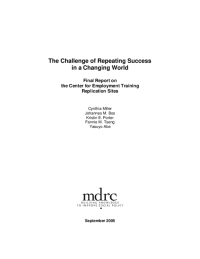The Challenge of Repeating Success in a Changing World
Final Report on the Center for Employment Training Replication Sites
Succeeding in the labor market depends now more than ever on having the right education and training. This reality poses a particular challenge for out-of-school youth, who are no longer connected to institutions designed to provide them with training and connect them to good jobs. The Center for Employment Training (CET) in San Jose, California, is one such institution. CET in San Jose, with its training in a worklike setting and involvement of local employers, showed promise as a program for youth, having produced large positive effects on their employment and earnings in two earlier studies in the late 1980s.
Based on these earlier results, the U.S. Department of Labor launched the Evaluation of the Center for Employment Training Replication Sites in the mid-1990s, which was designed to test whether the CET model could be implemented successfully in different settings and have similarly positive effects on the youth served. This final report on the evaluation summarizes the replication effort’s success and effects on youth after four and a half years.
Key Findings
- Replicating a program like CET is difficult, and fidelity to the original CET model varied greatly across the 12 sites. Only four of them (all older, CET-run programs) were deemed to have replicated the model with high fidelity. Sustaining program operations was a key challenge for several sites, and CET’s job development component proved difficult to fully implement.
- Effects on training were much larger in the high-fidelity sites than in the other sites. For example, access to CET in the high-fidelity sites increased total time in training by 218 hours through Month 12 and by 145 hours through Month 54. The effects in the medium- and low-fidelity sites were 55 hours through Month 12 and no difference through Month 54.
- At Month 54, youth who had access to the program were still more likely than youth in the control group to have received a training certificate, although much of the effect occurred during the first 12 months. Effects were much larger in the high-fidelity sites.
- In the high-fidelity sites — the fairest test of the model’s efficacy — access to CET did not increase youths’ employment or earnings during the 54-month follow-up period. The positive effects on women’s employment and earnings that were evident after 30 months did not persist beyond that point, while the negative effects on men’s employment also did not persist. Positive effects did emerge on earnings for younger youth in the forth and fifth years, but these findings must be interpreted with caution due to small sample sizes. Effects in the medium- and low-fidelity sites were either negligible or negative.
Access to CET did not lead to better outcomes than youth would have had on their own, either by enrolling in other training programs or by gaining experience in the labor market. Several factors may have contributed to the pattern of results. Compared with CET-San Jose in the earlier studies, the replication sites served a broader and perhaps more employable group of youth; the sites also operated in a stronger labor market and in a competitive environment that offered more training options, some of which may have been similar to the CET approach.






